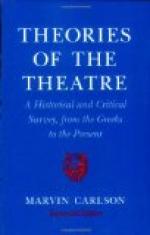The fact that a crowd’s eyes are more keenly receptive than its ears is the psychologic basis for the maxim that in the theatre action speaks louder than words. It also affords a reason why plays of which the audience does not understand a single word are frequently successful. Mme. Sarah Bernhardt’s thrilling performance of La Tosca has always aroused enthusiasm in London and New York, where the crowd, as a crowd, could not understand the language of the play.
Another primal characteristic of the mind of the crowd is its susceptibility to emotional contagion. A cultivated individual reading The School for Scandal at home alone will be intelligently appreciative of its delicious humor; but it is difficult to imagine him laughing over it aloud. Yet the same individual, when submerged in a theatre crowd, will laugh heartily over this very play, largely because other people near him are laughing too. Laughter, tears, enthusiasm, all the basic human emotions, thrill and tremble through an audience, because each member of the crowd feels that he is surrounded by other people who are experiencing the same emotion as his own. In the sad part of a play it is hard to keep from weeping if the woman next to you is wiping her eyes; and still harder is it to keep from laughing, even at a sorry jest, if the man on the other side is roaring in vociferous cachinnation. Successful dramatists play upon the susceptibility of a crowd by serving up raw morsels of crude humor and pathos for the unthinking to wheeze and blubber over, knowing that these members of the audience will excite their more phlegmatic neighbors by contagion. The practical dictum that every laugh in the first act is worth money in the box-office is founded on this psychologic truth. Even puns as bad as Mr. Zangwill’s are of value early in a play to set on some quantity of barren spectators and get the house accustomed to a titter. Scenes like the foot-ball episodes in The College Widow and Strongheart, or the battle in The Round Up, are nearly always sure to raise the roof; for it is usually sufficient to set everybody on the stage a-cheering in order to make the audience cheer too by sheer contagion. Another and more classical example was the speechless triumph of Henry V’s return victorious, in Richard Mansfield’s sumptuous production of the play. Here the audience felt that he was every inch a king; for it had caught the fervor of the crowd upon the stage.
This same emotional contagion is, of course, the psychologic basis for the French system of the claque, or band of hired applauders seated in the centre of the house. The leader of the claque knows his cues as if he were an actor in the piece, and at the psychologic moment the claqueurs burst forth with their clatter and start the house applauding. Applause begets applause in the theatre, as laughter begets laughter and tears beget tears.




